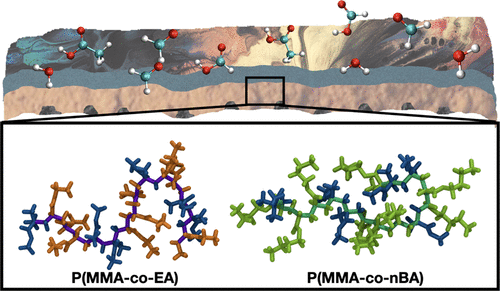当前位置:
X-MOL 学术
›
J. Phys. Chem. B
›
论文详情
Our official English website, www.x-mol.net, welcomes your feedback! (Note: you will need to create a separate account there.)
Acrylic Paints: An Atomistic View of Polymer Structure and Effects of Environmental Pollutants
The Journal of Physical Chemistry B ( IF 3.3 ) Pub Date : 2021-09-15 , DOI: 10.1021/acs.jpcb.1c05188 Aysenur Iscen 1 , Nancy C Forero-Martinez 1 , Omar Valsson 1 , Kurt Kremer 1
The Journal of Physical Chemistry B ( IF 3.3 ) Pub Date : 2021-09-15 , DOI: 10.1021/acs.jpcb.1c05188 Aysenur Iscen 1 , Nancy C Forero-Martinez 1 , Omar Valsson 1 , Kurt Kremer 1
Affiliation

|
Most of the artwork and cultural heritage objects are stored in museums under conditions that are difficult to monitor. While advanced technologies aim to control and prevent the degradation of cultural heritage objects in line with preventive conservation measures, there is much to be learned in terms of the physical processes that lead to the degradation of the synthetic polymers that form the basis of acrylic paints largely used in contemporary art. In museums, stored objects are often exposed to temperature and relative humidity fluctuations as well as airborne pollutants such as volatile organic compounds (VOCs). The glass transition of acrylic paints is below room temperature; while low temperatures may cause cracking, at high temperatures the sticky surface of the paint becomes vulnerable to pollutants. Here we develop fully atomistic models to understand the structure of two types of acrylic copolymers and their interactions with VOCs and water. The structure and properties of acrylic copolymers are slighlty modified by incorporation of a monomer with a longer side chain. With favorable solvation free energies, once absorbed, VOCs and water interact with the polymer side chains to form hydrogen bonds. The cagelike structure of the polymers prevents the VOCs and water to diffuse freely below the glass transition temperature. In addition, our model forms the foundation for developing mesoscopic and continuum models that will allow us to access longer time and length scales to further our understanding of the degradation of artwork.
中文翻译:

丙烯酸涂料:聚合物结构和环境污染物影响的原子观
大多数艺术品和文化遗产物品都在难以监控的条件下存放在博物馆中。虽然先进技术旨在根据预防性保护措施控制和防止文化遗产对象的退化,但在导致构成丙烯酸涂料基础的合成聚合物降解的物理过程方面还有很多东西需要学习用于当代艺术。在博物馆中,存放的物品经常会受到温度和相对湿度波动以及挥发性有机化合物 (VOC) 等空气污染物的影响。丙烯酸涂料的玻璃化转变低于室温;虽然低温可能会导致开裂,但在高温下,油漆的粘性表面容易受到污染物的影响。在这里,我们开发了完全原子模型来了解两种类型的丙烯酸共聚物的结构及其与 VOC 和水的相互作用。丙烯酸共聚物的结构和性能通过引入具有较长侧链的单体进行轻微改性。由于具有良好的溶剂化自由能,一旦被吸收,VOC 和水就会与聚合物侧链相互作用形成氢键。聚合物的笼状结构可防止 VOC 和水在玻璃化转变温度以下自由扩散。此外,我们的模型为开发细观和连续模型奠定了基础,这将使我们能够访问更长的时间和长度尺度,以进一步了解艺术品的退化。丙烯酸共聚物的结构和性能通过引入具有较长侧链的单体进行轻微改性。由于具有良好的溶剂化自由能,一旦被吸收,VOC 和水就会与聚合物侧链相互作用形成氢键。聚合物的笼状结构可防止 VOC 和水在玻璃化转变温度以下自由扩散。此外,我们的模型为开发细观和连续模型奠定了基础,这将使我们能够访问更长的时间和长度尺度,以进一步了解艺术品的退化。丙烯酸共聚物的结构和性能通过引入具有较长侧链的单体进行轻微改性。由于具有良好的溶剂化自由能,一旦被吸收,VOC 和水就会与聚合物侧链相互作用形成氢键。聚合物的笼状结构可防止 VOC 和水在玻璃化转变温度以下自由扩散。此外,我们的模型为开发细观和连续模型奠定了基础,这将使我们能够访问更长的时间和长度尺度,以进一步了解艺术品的退化。聚合物的笼状结构可防止 VOC 和水在玻璃化转变温度以下自由扩散。此外,我们的模型为开发细观和连续模型奠定了基础,这将使我们能够访问更长的时间和长度尺度,以进一步了解艺术品的退化。聚合物的笼状结构可防止 VOC 和水在玻璃化转变温度以下自由扩散。此外,我们的模型为开发细观和连续模型奠定了基础,这将使我们能够访问更长的时间和长度尺度,以进一步了解艺术品的退化。
更新日期:2021-09-30
中文翻译:

丙烯酸涂料:聚合物结构和环境污染物影响的原子观
大多数艺术品和文化遗产物品都在难以监控的条件下存放在博物馆中。虽然先进技术旨在根据预防性保护措施控制和防止文化遗产对象的退化,但在导致构成丙烯酸涂料基础的合成聚合物降解的物理过程方面还有很多东西需要学习用于当代艺术。在博物馆中,存放的物品经常会受到温度和相对湿度波动以及挥发性有机化合物 (VOC) 等空气污染物的影响。丙烯酸涂料的玻璃化转变低于室温;虽然低温可能会导致开裂,但在高温下,油漆的粘性表面容易受到污染物的影响。在这里,我们开发了完全原子模型来了解两种类型的丙烯酸共聚物的结构及其与 VOC 和水的相互作用。丙烯酸共聚物的结构和性能通过引入具有较长侧链的单体进行轻微改性。由于具有良好的溶剂化自由能,一旦被吸收,VOC 和水就会与聚合物侧链相互作用形成氢键。聚合物的笼状结构可防止 VOC 和水在玻璃化转变温度以下自由扩散。此外,我们的模型为开发细观和连续模型奠定了基础,这将使我们能够访问更长的时间和长度尺度,以进一步了解艺术品的退化。丙烯酸共聚物的结构和性能通过引入具有较长侧链的单体进行轻微改性。由于具有良好的溶剂化自由能,一旦被吸收,VOC 和水就会与聚合物侧链相互作用形成氢键。聚合物的笼状结构可防止 VOC 和水在玻璃化转变温度以下自由扩散。此外,我们的模型为开发细观和连续模型奠定了基础,这将使我们能够访问更长的时间和长度尺度,以进一步了解艺术品的退化。丙烯酸共聚物的结构和性能通过引入具有较长侧链的单体进行轻微改性。由于具有良好的溶剂化自由能,一旦被吸收,VOC 和水就会与聚合物侧链相互作用形成氢键。聚合物的笼状结构可防止 VOC 和水在玻璃化转变温度以下自由扩散。此外,我们的模型为开发细观和连续模型奠定了基础,这将使我们能够访问更长的时间和长度尺度,以进一步了解艺术品的退化。聚合物的笼状结构可防止 VOC 和水在玻璃化转变温度以下自由扩散。此外,我们的模型为开发细观和连续模型奠定了基础,这将使我们能够访问更长的时间和长度尺度,以进一步了解艺术品的退化。聚合物的笼状结构可防止 VOC 和水在玻璃化转变温度以下自由扩散。此外,我们的模型为开发细观和连续模型奠定了基础,这将使我们能够访问更长的时间和长度尺度,以进一步了解艺术品的退化。



























 京公网安备 11010802027423号
京公网安备 11010802027423号